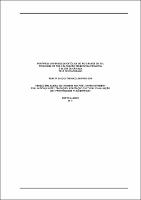| Share record |


|
Please use this identifier to cite or link to this item:
https://tede2.pucrs.br/tede2/handle/tede/6974| Document type: | Tese |
| Title: | Versão brasileira do Shriners Hospital Upper Extremity Evaluation (SHUEE) : tradução, adaptação cultural e avaliação das propriedades psicométricas |
| Author: | Panisson, Renata D'Agostini Nicolini  |
| Advisor: | Donadio, Márcio Vinícius Fagundes |
| First advisor-co: | Mattiello, Rita |
| Abstract (native): | Introdução: Indivíduos com paralisia cerebral (PC) frequentemente apresentam comprometimento do membro superior levando a limitações na funcionalidade. A avaliação do membro superior apenas com o exame físico tradicional pode ser limitada nesses indivíduos. O uso de escalas e avaliações específicas e validadas auxiliam os profissionais da saúde no entendimento dessas limitações e no planejamento do tratamento. No entanto, no Brasil não se tem a disposição uma escala validada que avalie a função do membro superior e direcione o plano de tratamento em indivíduos com PC. Objetivo: Esta tese teve como objetivo geral validar o instrumento de avaliação do membro superior, Shriners Hospital Upper Extremity Evaluation (SHUEE), para indivíduos com PC hemiplégica da população brasileira. Material e métodos: Estudo transversal, de validação, no qual foi realizada a tradução do manual e do instrumento. As propriedades psicométricas avaliadas foram confiabilidade e validade convergente. A confiabilidade foi determinada através da consistência interna (coeficiente α de Cronbach, α-C), efeito teto e chão, sensibilidade à mudança e concordância intra e inter-observador. A validade convergente foi realizada utilizando-se o Pediatric Motor Activity Log (PMAL), a escala de autocuidados do Pediatric Evaluation of Disability Inventory (PEDI) e o Manual Ability Classification System (MACS). Resultados: Foram avaliados 21 indivíduos com PC hemiplégica e idade média de 8,73±3,98 anos. Após a tradução do instrumento, não houve necessidade de adaptação cultural. O coeficiente α-C total do SHUEE foi de 0,887 (IC 95% 0,745- 0,970). A sensibilidade à mudança foi calculada em 5 indivíduos que realizaram aplicação de Toxina Botulínica tipo A e fisioterapia, apresentando diferença significativa entre a avaliação pré e pós-tratamento na Análise Posicional Dinâmica. A validade convergente mostrou correlação significativa da Análise Funcional Espontânea e Análise Posicional Dinâmica com o PMAL, PEDI e MACS. Todos os itens do SHUEE apresentaram concordâncias fortes, tanto na avaliação intra quanto na inter-observador (ICC maior do que 0,9). Conclusão: Os resultados apresentados na tese nos permitem concluir que a versão do SHUEE em português do Brasil demonstrou um bom desempenho em relação à confiabilidade e validade convergente, sugerindo ser uma ferramenta adequada e confiável para os indivíduos com PC hemiplégica da população brasileira. |
| Abstract (english): | Introduction: Individuals with cerebral palsy (CP) often have upper limb impairment leading to limitations in functionality. The use of specific and validated scales assists health professionals in the understanding of these limitations and treatment planning. However, Brazil does not have available validated scales to assess the upper limb function and direct the treatment plan in individuals with CP. Objective: This thesis aimed at validating the upper limb assessment tool, Shriners Hospital Upper Extremity Evaluation (SHUEE), for individuals with hemiplegic CP of the Brazilian population. Methods: Cross-sectional validation study in which the translation of the manual and instrument was performed. The evaluated psychometric properties were reliability and convergent validity. Reliability was determined by internal consistency (Cronbach α coefficient, α-C), ceiling and floor effect, sensitivity to change and intra and interobserver agreement. Convergent validity was performed using the Pediatric Motor Activity Log (PMAL), the self-care scale of the Pediatric Evaluation of Disability Inventory (PEDI) and the Manual Ability Classification System (MACS). Results: A total of 21 individuals with hemiplegic CP, mean age of 8.73±3.98 years, were evaluated. The instrument was translated and there was no need for cultural adaptation. The total α-C coefficient of the SHUEE was 0.887 (95% CI 0.745 to 0.970). Sensitivity to change was calculated in 5 subjects who underwent application of Botulinum Toxin Type A and physical therapy, with a significant difference in the Dynamic Positional Analysis between pre and post-treatment evaluations. The convergent validity showed significant correlation of Spontaneous Functional Analysis and Dynamic Positional Analysis with PMAL, PEDI and MACS. All items of SHUEE showed high intra and inter-observer agreement (ICC greater than 0.9). Conclusion: The results presented in this thesis allow us to conclude that the Brazilian Portuguese version of SHUEE demonstrated a good reliability and convergent validity, suggesting that it is a reliable tool for the upper limb evaluation of Brazilian children and adolescents with hemiplegic CP. |
| Keywords: | PSICOMOTRICIDADE - TESTES MEMBROS SUPERIORES - ANATOMIA PARALISIA CEREBRAL NEUROLOGIA PEDIATRIA MEDICINA |
| CNPQ Knowledge Areas: | CIENCIAS DA SAUDE::MEDICINA |
| Language: | por |
| Country: | Brasil |
| Publisher: | Pontifícia Universidade Católica do Rio Grande do Sul |
| Institution Acronym: | PUCRS |
| Department: | Faculdade de Medicina |
| Program: | Programa de Pós-Graduação em Medicina/Pediatria e Saúde da Criança |
| Access type: | Acesso Aberto |
| URI: | http://tede2.pucrs.br/tede2/handle/tede/6974 |
| Issue Date: | 4-Aug-2016 |
| Appears in Collections: | Programa de Pós-Graduação em Pediatria e Saúde da Criança |
Files in This Item:
| File | Description | Size | Format | |
|---|---|---|---|---|
| TES_RENATA_DAGOSTINI_NICOLINI_PANISSON_PARCIAL.pdf | Texto Parcial | 680.33 kB | Adobe PDF |  Download/Open Preview |
Items in DSpace are protected by copyright, with all rights reserved, unless otherwise indicated.




